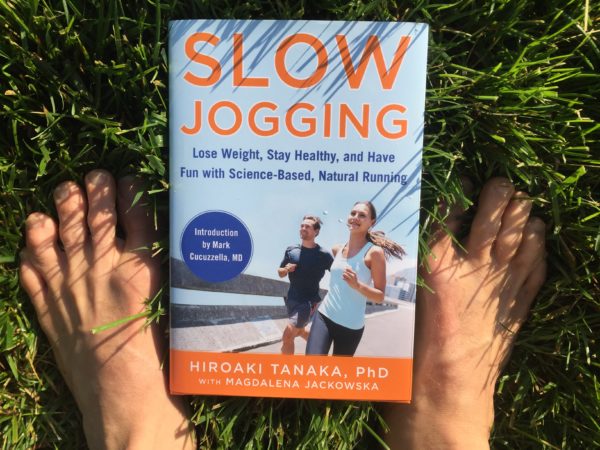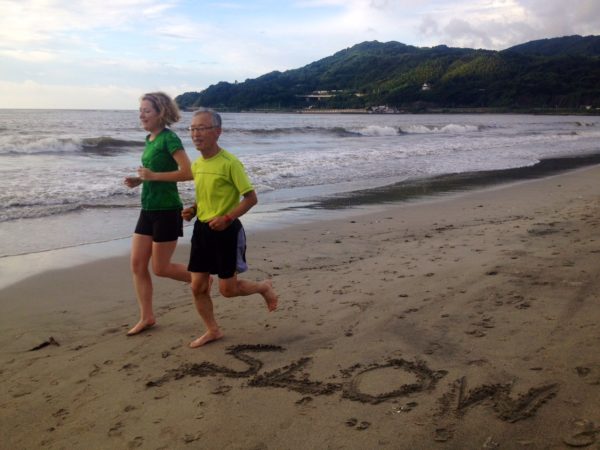I had the privilege to write the forward to a just released book “Slow Jogging– Lose Weight, Stay Healthy, and Have fun with Science Based, Natural Running” by Dr. Hiroaki Tanaka. My friend Dr. Tanaka is one of the most inspiring scientists and self-experimenting athletes I’ve met. Dr. Tanaka has changed my life and his message now is being shared with the US Air Force to help create injury free and more fit Airman.
I had the privilege of first meeting Dr. Tanaka, a Professor at Fukuoka University, Japan, at the Boston Marathon in 2011 after giving a talk on minimal running and the benefits of “easy.” Dr. Tanaka showed me his heart rate and pace progression from building endurance, learning good running technique, and reducing the shoe. His program led to a 2:38 marathon at age 50 after reversing Type 2 Diabetes, his inspiration to start running again. Dr. Tanaka later came as a guest to the U.S. in 2012 for one of my Healthy Running courses and gave a community talk on “slow jogging.” In front of everyone, he demonstrated this easy and relaxed movement which almost anyone can do safely. He called it niko niko meaning “smile”.
He also gave me a copy of his first book published in Japanese, and whose title translated in English to mean “Run with Smile, Midfoot Strike.” Like Dr. Tanaka I am a big believer in “slow jogging” as a foundation for fitness and health. Master running really easy and slow to develop a soft and springy landing. Running hard and fast come later, unless you are a child or your body actually still moves like one.
“Slow jogging” is essentially for recovery too. Most do not really understand the term recovery when it comes to activity or exercise. Simply stated any recovery activity, whether it be a walk, jog, massage, swim, medication, should make you feel better after the activity than you did before. For those with busy lives most of our physical activity should be recovery from the stresses of life, not additional stress.
What are some of the features of “slow jogging” as described in the book:
The term “slow jogging” was chosen to emphasize that even in a sport traditionally associated with moving fast, slow can be a perfectly good way to do it. Since as early as the 1970s, Dr. Tanaka has been researching how exercise of low intensity performed regularly can help our health in so many ways. Longevity and health is about the mitochondria functioning, and this activity is miracle grow for your aerobic factories. In Japan many are seen now doing this activity which is actually slower than a fast walk. Even the elites are recovering with this easy movement between intense sessions.
Start slow , really slow, and do not be concerned if you are overtaken by walkers. I slow jog with my dog and it is great for both of us. My neighbors often wonder why someone like myself who can still run marathons fast is running slower than anyone else in the neighborhood. . If you cannot smile, talk easily or sing you are going too fast . The key to success is to keep your niko niko (smile) pace. Niko niko pace can be very different for each one of us. Unfit youth often have a niko niko pace slower than a fit elderly.
The easiest way is to listen to your body. If you are out of breath and not able to have a conversation, you should slow down – simple as that. Slow down to be able to talk at ease or if you are running alone – sing your favorite songs. For those of you who are at the beginning of your jogging adventure, niko niko pace will probably be lower that walking speed – we suggest to start at 3-5 km/h.
With “slow jogging” you also master the art of landing soft. Stand up and jump a couple of times as if you are jumping rope, and land soft and springy. Now jump and land on your heels and you feel a painful hard landing. When landing soft and more to the forefoot your Achilles tendon gives you natural spring. Landing on your heels can cause a lot of pressure to your joints. Jog in place now and move forward a bit and backwards a bit. You got it!
What kind of shoe is best for this? Most of the modern running shoes, especially designed for beginners, have a thick sole invented to minimalize shock resulting from landing on the heels. So simple shoes with thin flexible soles wide at the toes are recommended. Create a good balance and posture.
Try counting your step rhythm too. It should be close to 180 steps a minute. Each footfall counts. Observe the rhythm of kids jumping rope or traditional dance. Most have a sticky rhythm much slower than this. Breathe slow and fill the belly too. This in itself is relaxing and stimulates the parasympathetic system, which is the opposite of the stress response. You should be able to talk and sing.
One of the beauties of “slow jogging” is you can do it anywhere- the mall, airports, and at the workplace when you need to move a little to relax but not get sweaty or need change of clothes. Experienced runners who are injured or tired are learning the benefits of this. The best runners from a generation ago, Bill Rodgers and Frank Shorter for example, all had days where they ran almost ridiculously slow.
A final benefit is getting out in nature. There is a magic in open space and sunshine that defies the lab. So make your goal this summer to master the art of running easy and slow.
Slow Jogging is now available on Amazon.




Thanks for posting. Please write more articles on the Slow Jogging. Would be nice if there were a website specifically for it.